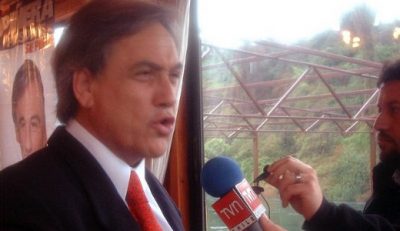Chile’s Right-wing President on the Ropes. Sebastian Piñera

This article was originally published in 2011.
At the beginning of 2010, right-wing billionaire Sebastian Piñera Echenique defeated Eduardo Frei Ruiz-Tagle, candidate of the “Concertacion” coalition of social democrats and centrists, which has ruled Chile since the end of the Pinochet dictatorship, by a margin of 51 to 49 percent in a runoff election. In October of that year, Piñera managed to manipulate the media into giving him credit for the rescue of 33 miners in a collapsed copper mine, and his popularity rating went up to 63 percent.
Now, as the latest of blows from a mass upsurge not seen since the days of socialist President Salvador Allende, Piñera’s popularity rate is at 31 percent. And 31 of the 33 miners are suing the Chilean government for negligence, for not having properly supervised safety conditions at the privately owned San Jose copper and gold mine in the bleak Atacama region. The mine had a history of safety problems, which the plaintiffs say were not properly dealt with by the responsible government agency, the National Service of Geology and Mines (Sernageomin). They are asking courts for the equivalent of U.S. $16 million. They are also suing the owners, according to AFP.
The announcement of the suit comes on top of massive student demonstrations, a one-day strike in the biggest copper mine in the world, and a long running fight against the construction of a huge hydroelectric project farmers and environmentalists say will wreck an environmentally sensitive area. In the Chilean Congress, deputies from the Communist Party and its allies have introduced legislation to nationalize private mining concerns.
The student protests have roots in the measures taken in education by the military regime of General Agosto Pinochet Ugarte, who overthrew socialist President Salvador Allende Gossens on September 11, 1973. Pinochet broke up the national education system by devolving control to local communities, which had the effect of greatly increasing inequality of educational resources and quality between rich and poor students.
Earlier this year, the Ministry of Education announced sharp cuts to the budgets for schools and universities. Almost immediately, protests arose. Tens of thousands of students and teachers, in this country of 15 million people, have been marching and protesting since the middle of June. Protesters want an end to the decentralized system and its inequities, and budget increases to increase educational opportunities from kindergarten to university for the poor and working class.
Students in the United States can sympathize, especially, with the Chilean students’ complain that to study, they have to get themselves deeply into debt through student loans. At writing, Piñera made an offer of an increase in scholarship funds, but student and teacher organizations are holding out for much more money and a complete restructuring of the system.
On July 14, a particularly militant demonstration in downtown Santiago, Chile’s capital, led to a wild melee between students and police, with a number of injuries and arrests. Chilean Communist Party deputy Lautero Carmona hailed the marchers and denounced the repression, pointing out that, against the expectations of the government, the students had managed to put together a protest of over 150,000 people. Carmona also warned that repressive actions toward protesters reflect nostalgia for the Pinochet days within the present government.
On July 11, as many as 40,000 unionized employees and subcontracted workers, members of the Federacion de Trabajadores de Cobre (Copper Workers Federation), carried out a highly effective one-day strike at the Chuquicamata mine, the largest copper mine in the world, which is run by the government’s Codelco company. Other Codelco units were also struck. The strike by the miners, who have some of the best pay and benefit scales in Chile, was in response to “restructuring” plans announced by management. Management wants to cut about 2,600 jobs, but the union suspects that privatization schemes are also in the works.
Chuquicamata produces about a third of Chile’s copper, which is a big part of copper production worldwide. The Chuquicamata mine was nationalized by Allende’s socialist government in 1971, and never re-privatized up till now. But the head of Codelco is now Diego Hernandez, who formerly headed Chilean operations of the private Anglo-Australian mining company BHP Billiton, giving the appearance of a conflict of interest.
The environmental and farmers protests in southern Chile have to do with a massive hydroelectric project to be carried out by the HidroAysen Company, the BBC reports. The project, designed to increase the generation of power other than from fossil fuels, involves damming two important rivers in Patagonia, in the far south of the country. Local farmers object to being forced off their lands, and environmentalists worry that the damming of the rivers will upset delicate ecological balances. They also say that Chile would not need huge expansions of its electrical generating capacity if the huge overuse of power by private industry, especially the mines, were better regulated. Opponents of the dams have gone to court to stop them, as well as protesting.
To these massive protests one may add a long conflict over the treatment of the Mapuche people, the major indigenous group in Chile, and investigations into the real circumstances of the 1973 deaths of President Allende and of communist poet and Nobel Prize winner Pablo Neruda.
*
Note to readers: please click the share buttons above or below. Forward this article to your email lists. Crosspost on your blog site, internet forums. etc.
Emile Schepers is a veteran civil and immigrant rights activist. Emile Schepers was born in South Africa and has a doctorate in cultural anthropology from Northwestern University. He has worked as a researcher and activist in urban, working-class communities in Chicago since 1966. He is active in the struggle for immigrant rights, in solidarity with the Cuban Revolution and a number of other issues. He now writes from Northern Virginia.

